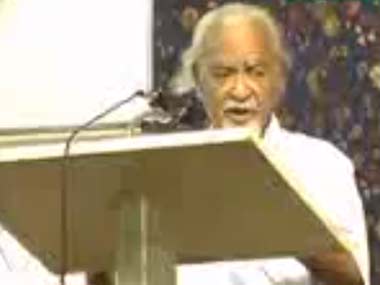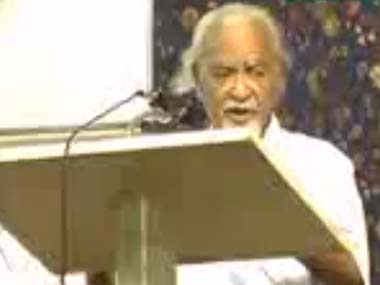by DVL Padma Priya [caption id=“attachment_1002173” align=“alignleft” width=“380”]  A YouTube screengrab of Rao[/caption] Hyderabad: Burugula Narsing Rao belongs to the generation of Telangana activists who have seen it all; from the Razakar movement leading to the police firing in 1948, to the formation of Andhra Pradesh and the initial Telangana separation movement through the 1950s and 1960s, and the resurgence of the Telangana movement of the last decade. And when Telangana was finally formed, Rao says he heaved a sigh of relief. According to him, the separation of Telangana was an inescapable inevitability- something that should have happened when India’s states were first being formed. Hailing from a village in the Mahbubnagar district of Telangana region, Burugula Narsing Rao was born into a political family. His uncle Burugula Ramakrishna Rao was the first Chief Minister of erstwhile Hyderabad State and had led a movement against the Nizam for the merger of Hyderabad State into the Indian Union. “Initially I was part of the Visalandhra movement which was aimed at making Andhra Pradesh a separate State based on its language. I was part of it for three-four years when i felt disillusioned by the movement as i would see first-hand how the Telanganites were discriminated by the Andhra people", he said. Rao spoke to Firstpost on a number of issues ranging from why it was important to have a separate state for Telangana to the battle for Hyderabad and the future of India’s 29th state. Why Telangana wanted a separate state “The region (Telangana) has always been an oppressed region. First, under the Nizam’s rule where the majority people were ridiculed on the basis of their language, culture and religion. The very fact that question of Telangana has been there for so many years is a reflection of this ongoing suppression,” he says pointing out the separation of Telangana today is a perfect example of why States with two different backgrounds should not be bought together on the basis of language. “Even during the freedom movement, there were many leaders who felt that both the regions should not be together but Congress had made up its mind to carve states on linguistic basis.” Interestingly, he says one of the first State Reorganisation Committee s(SRC) (Fazal Ali Commission) had recognised the disparities between both the regions culturally and economically and suggested that Telangana State be kept separated from the Andhra Pradesh region for a period of five years and that the choice should be left to the Telangana assembly if they wanted to become part of Andhra Pradesh. The absence of a common history between the two regions too is one of the reasons, according to him, why there never was any integration between the two regions. While Hyderabad and surrounding districts was under the Qutub Shahi rulers followed by Asif Jahi, the Andhra regions were under the Kakatiya rulers. “Andhra Pradesh is the perfect example of how unless a political historical process is not rooted properly, it will fall apart,” he says. The evolution of the Telangana movement Having been part of the movement from close quarters, Rao says that the last decade’s Telangana movement was propelled by the masses and people from different quarters of the society. “In the 1960’s it was the middle class, students and the employees who were at the forefront of the agenda as they felt discriminated. It had its impact on rural areas but not as much as it has been in the recent past. The canvas now has been much wider and has engulfed all sections of the society. This way the recent movement has been very unique with everyone from doctors to engineers to farmers are part of it in some form or the other,” he says. [caption id=“attachment_1002177” align=“alignleft” width=“380”]  PTI[/caption] The fight for Hyderabad Ask him about the fight for Hyderabad and he laughs. “What is 45 years in the history of a nation is not a long time at all. Nobody is asking anyone to leave. Surely, new vested interests wont be allowed to entrench here. But the fight seems to be purely economical. And when Andhra leaders say development what sort of development are they talking about? What have they contributed towards especially in the case of industries which create employment? One has to remember that Hyderabad in 1956 had industrial infrastructure even then. One of the biggest issues the Andhra region faces is the lack of a city the size of Hyderabad and this will continue to plague them in the coming years. The Naxal issue Despite the Home Ministry expressing concerns over naxalism, the octogenarian is of the belief that the concerns are overrated and misplaced. “The naxal movement is no longer as strong as it was a few decades ago. Yes, the first armed struggle against the Nizam was led by those from Telangana and this gave rise to other movements such as the naxal movement but the situation is quite different now. Youngsters have more opportunities now and the people don’t want any more tension. The last decade has affected those from the region psychologically and they are now relieved and want to move ahead with their lives." The future of Telangana state Rao is optimistic of the political future of the Telangana state and says that there will be political stability for sure. Going forward he feels that the new leadership should ensure that the promises on the basis of which Telangana was formed should be kept and delivered to the people of the region who have fought for it for so long. “Invest in productive industries and develop agriculture in the region. Telangana region has a vast network of tanks, streams and bunds. These should be revived. Similarly, the government should develop small scale industries and cottage industries. The weaving villages of Telangana such as Sircilla, Pochampally, Gadwal etc should be revived and supported,” he says. Mr Narsing Rao believes that Telangana has the potential to carve an identity for itself and embrace its culture wholeheartedly.
One of Telangana’s oldest activists, Burugula Narsing Rao, spoke to Firstpost on a number of issues ranging from why it was important to have a separate state for Telangana to the battle for Hyderabad and the future of India’s 29th state.
Advertisement
End of Article
Written by FP Archives
see more


)

)
)
)
)
)
)
)
)



